Harris’s Sparrow
Rare birds show up in Ohio every so often. This causes excitement in the local birding world- there are websites created to share knowledge of these occurrences. Funny enough, winter isn’t automatically associated with rare birds by many people, but actually it can be a good season to see those life-list species you’ve never seen before. Winter may be a time when there is less of a variety of birds around, but don’t stop birding in the cold weather, or you may miss something good!
A case in point happened last week out at Pickerington Ponds Metro Park, a place normally more well-known for its waterfowl and raptor population. A bird was spotted whose normal range this time of year is a few states to the west. Even better (for spotting purposes)- this bird was seen daily at a particular feeder. I headed out one morning to see this rare visitor.
Pickerington Ponds is fairly quiet this time of year, with its bodies of water frozen over, and its picnic areas unused in the snowy weather. There’s a lot of fields and some scrub woods in the area as well.
These dedicated cyclists stopped by the park and then continued on along the Blacklick Creek Greenway Trail.
These are old Great Blue Heron nests at one of the ponds- in the spring they’ll be in use once more.
This was the particular area I was looking for.
A hawk was in the area too- the local birds seemed to be on the lookout.
In addition to me and the hawk, there were several birders looking for the rare bird.
This was the famous feeder, whose sunflower seeds were a popular hit with many birds.
There are at least 6 species of birds on the feeder in this picture.
Uhoh- here comes someone for breakfast who likes to monopolize the feeder…
Yeah, I was afraid this would happen- our feathered friends have been replaced!
Tree Sparrow looks rather miffed at the furred feeder hog.
A couple of young White-Crowned Sparrows join Tree Sparrow on the ground, looking for other grub.
An adult White-Crowned Sparrow joins them.
Name this mystery bird!
The feeder was cleared by one of the birders who walked up to the Gray Squirrel and shooed him off. Most birders do not interfere with nature while observing it, but all of us were glad that the birds could return once more to the feeder- and the squirrel had eaten plenty of seeds. We wanted to see the rare bird!
Sure enough, the star of the show appeared- actually, he had been hanging out all morning, but this was my first close-up look at him. This is a Harris’s Sparrow. He is a first-year male by his markings. He may be mistaken for a House Sparrow at a distance, but note his pink bill. This is a larger sparrow in size.
Here’s our buddy coming to check out the feeder. He was the only one of his kind here, blending in with the other sparrows.
Harris’s Sparrows are the only bird in the world that nests exclusively in Canada, and they come south in winter- I’m guessing that this was this male’s first southern migration, because instead of showing up in the Great Plains, he veered off course and ended up in Ohio- luckily for us birders who’d never seen one before!
This guy’s black bib is a signaling mechanism in flocks of his own kind- the bigger the bib, the older and more experienced the bird, and the higher in the male pecking order they are.
House Sparrows have a similar bib size pecking order, I wonder if the locals accept him as one of them?
OK, he’s looking really hungry now. Note that the Cardinals keep a prudent eye out for swooping hawks.
This bird got along well with the pair of Cardinals, and had a good breakfast of sunflower seeds.
Certainly winter is not the season most people pick to be outdoors. But don’t let that throw you off, there can be more to see than you think outside, even with ponds frozen over, dead brown plants, and snow-covered grass. Nature can always surprise you. I hope our wrong-way bird makes it back to his nesting ground in the spring, the boreal forests of northern Canada.



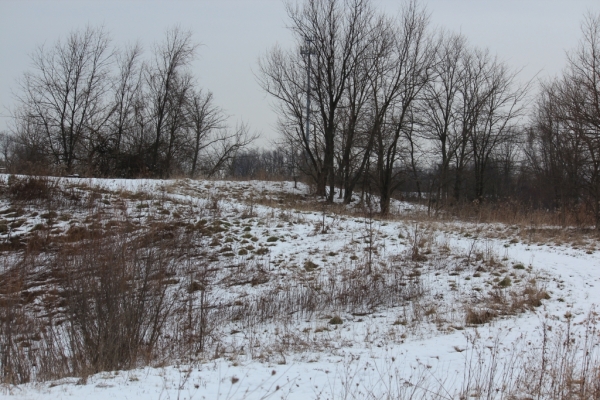









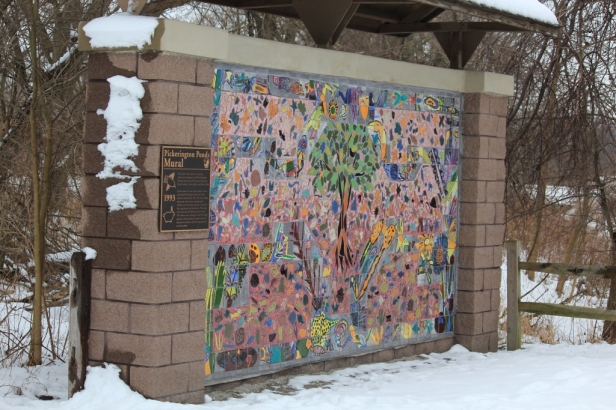

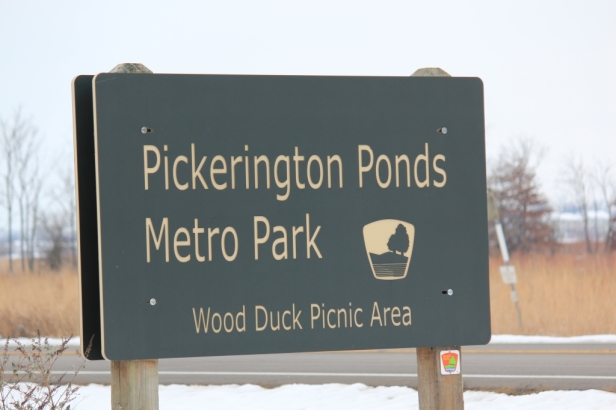



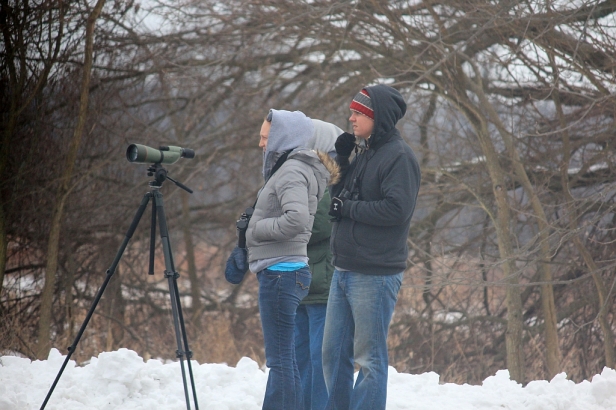


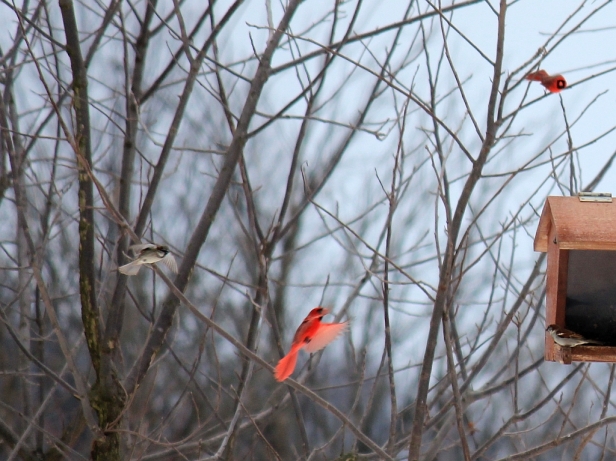

















Beautiful, thank you for sharing it with us!
Thanks, Kolytyi!
Lovely shots! I hope the Harris’ Sparrow makes it back to Canada. The cardinals certainly draw the eye with their almost fluorescent colour. The mystery bird I would say is some kind of wren, although I am a bit hazy about US birds! I look forward to finding out!
You’re right, Jo! I bet you know American birds better than I know UK birds 🙂
Cardinals are a favorite here- as a matter of fact, they are the official State Bird of Ohio (and a couple of other states).
Confession? My favorite photo is the squirrel! How do they always manage such a look of innocence?
Haha! Sooo true, those scoundrels!
The wren is probably a Carolina Wren; at least, that’s what we have in Virginia. Very nice post. I particularly liked the signaling mechanism information about the bib size and the pecking order.
Good ID, Jo Ann!
Great post! I wonder if the Harris Sparrow was blown off course in one of the storms that have blown across North America? We seem to have quite a few rare (to this area) birds showing up this winter as well.
That’s a good point- funny enough, another Harris’s Sparrow was reported elsewhere in Ohio recently as well- this is a rare bird here. And a Black Scoter showed up here after Hurricane Sandy. I wouldn’t be surprised if storms are indeed bringing us such surprises.
Wonderful: love the photos! Felt I’d been bird-watching, too. We’re also seeing new birds in our area during migrations; I suppose, a consequence of climate change…thank you for a lovely post!
Thank you, Catherine! I wonder if we will see more new visitors than usual.
Great post, Tracy. I figured it was a wren, but didn’t know which one until Jo Ann IDed it in her comment. I agree about getting out in the winter. Here in my area we have more birds in the winter than in the summer.
Having more birds in the winter- now that’s really cool, Bob! Thanks!
I thought that looked like our Carolina wrens. Didn’t know they wandered that far. 🙂 It’s great to see a new bird, thanks for sharing your sparrow. Had to smile at, “In addition to me and the hawk…”
Thanks Patti 🙂
Carolina gets some good birds named for it- not only the Wren, but the Chickadee too.
I drove the hour and a half to see if I could spot the Harris Sparrow for my life list only to wait over 2 hours to dip on the bird. It showed up 60 minutes later. I’m still not hearing if it still shows up, I need this bird for my life list.
Sorry to hear this Les- I haven’t read anything about the bird since Jan. 6th. When I saw it, it was between 9:30 and 11:30 in the morning. I’ll keep an eye out!
I was there between 9 and 11:30. It showed up at 12:30. Besides being a new bird it would have added another bird to my January 100 species list
Whoa, it was late that day 😦
Wonderful post, Tracy. I need to get out and get video and photos of birds in winter for my current project; you have inspired me!
Glad to hear that, Lynn- look forward to seeing it! 🙂
Really cool to see something like that!
Most definitely, Montucky!
I’ve never gone outside exclusively looking for birds, so thank for taking me along!
Thanks, Gardener- your reports on the flora of New Hampshire are always informative!
Amazing photos. Gorgeous. 🙂
Thanks, E.C.!
Such a hub of activity! It has been so quiet here lately despite a couple feeders. Thanks for sharing!
It’s hit or miss here in the winter, depending on where you look. Feeders tend to be popular though!
Reblogged this on birdfeederauthority and commented:
Awesome!
Many thanks!
That Harris’s Sparrow was worth the wait!
It surely was! 🙂